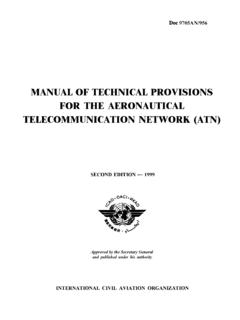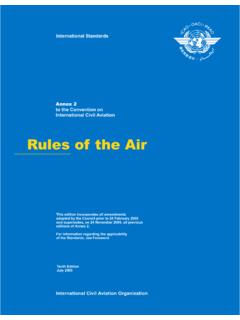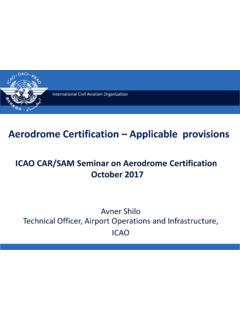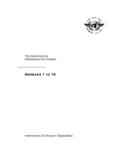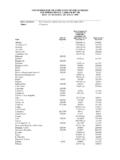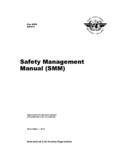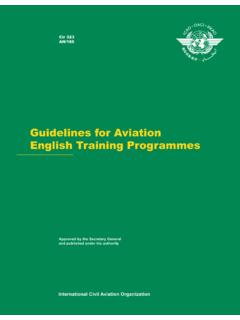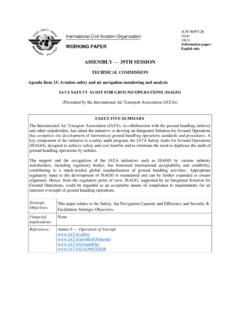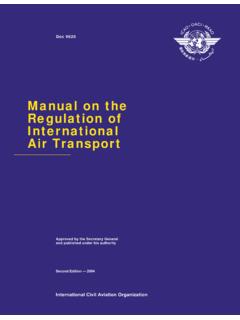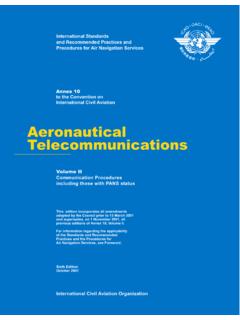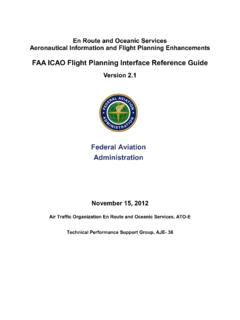Transcription of Annex 10 Radio Navigation Aids - ICAO
1 Tel.: +1 514-954-8219 ext. 8178 Ref.: AN 7 6 July 2021 Subject: Proposals for the amendment of Annex 10, Volume I to: a) support the introduction of dual-frequency, multi-constellation (DFMC) global Navigation satellite system (GNSS) by adding provisions for additional frequencies of operation for the global positioning system (GPS), the global Navigation satellite system (GLONASS) and the satellite-based augmentation system (SBAS), and by introducing provisions for the new BeiDou Navigation Satellite System (BDS) and Galileo system; and b) support ionospheric gradient mitigation for the ground-based augmentation system (GBAS). Action required: Comments to reach Montr al by 6 January 2022 Sir/Madam, 1. I have the honour to inform you that the Air Navigation Commission (ANC), at the tenth meeting of its 217th Session held on 22 June 2021, considered proposals developed by the sixth meeting of the Navigation Systems Panel (NSP/6) to amend the Standards and Recommended Practices (SARPs) in Annex 10 aeronautical Telecommunications, Volume I Radio Navigation Aids to: a) support the introduction of dual-frequency, multi-constellation (DFMC) global Navigation satellite system (GNSS) by adding provisions for additional frequencies of operation for the global positioning system (GPS), the global Navigation satellite system (GLONASS) and the satellite-based augmentation system (SBAS), and by introducing provisions for the new BeiDou Navigation Satellite System (BDS) and Galileo system; and b) support ionospheric gradient mitigation for the ground-based augmentation system (GBAS).
2 The Commission authorized the transmission of these proposals to Contracting States and appropriate international organizations for comments. 2. Background information on the aforementioned proposals is provided in Attachment A. The proposed amendments to Annex 10, Volume I are contained in Attachment B. The rationales have been provided in text boxes immediately following each proposal. 999 Robert-Bourassa BoulevardMontr al, QuebecCanada H3C 5H7 Tel.: +1 514 954-8219-Fax: +1 514 954-6077-Email: AviationOrganizationOrganisationde l aviation civileinternationaleOrganizaci nde Aviaci n CivilInternacionalМеждународнаяорганизац иягражданскойавиации - 2 - 3. In examining the proposed amendments, you should not feel obliged to comment on editorial aspects as such matters will be addressed by the ANC during its final review of the draft amendment. 4. May I request that any comments you wish to make on the amendment proposals be dispatched to reach me not later than 6 January 2022.
3 To facilitate the processing of replies with substantive comments, I invite you to submit an electronic version in Word format to The ANC has asked me to specifically indicate that comments received after the due date may not be considered by the Commission and the Council. In this connection, should you anticipate a delay in the receipt of your reply, please let me know in advance of the due date. 5. In addition, the proposed amendment to Annex 10, Volume I is envisaged for applicability on 2 November 2023. Any comments you may have thereon would be appreciated. 6. The subsequent work of the ANC and the Council would be greatly facilitated by specific statements on the acceptability or otherwise of the amendment proposal. 7. Please note that for the review of your comments by the ANC and the Council, replies are normally classified as agreement with or without comments , disagreement with or without comments or no indication of position . If in your reply the expressions no objections or no comments are used, they will be taken to mean agreement without comment and no indication of position , respectively.
4 In order to facilitate proper classification of your response, a form has been included in Attachment C which may be completed and returned together with your comments, if any, on the proposals in Attachment B. Accept, Sir/Madam, the assurances of my highest consideration. Fang Liu Secretary General Enclosures: A Background information B Proposed amendment to Annex 10 aeronautical Telecommunications, Volume I Radio Navigation Aids C Response form ATTACHMENT A to State letter AN 7 BACKGROUND INFORMATION 1. GENERAL The proposed amendment, as detailed in Attachment B, relates to: a) support of the introduction of dual-frequency, multi-constellation (DFMC) global Navigation satellite system (GNSS) by adding provisions for additional frequencies of operation for the global positioning system (GPS), the global Navigation satellite system (GLONASS) and the satellite-based augmentation system (SBAS), and by introducing provisions for the new BeiDou Navigation Satellite System (BDS) and Galileo system; and b) support of ionospheric gradient mitigation for the ground-based augmentation system (GBAS).
5 2. DUAL-FREQUENCY, MULTI-CONSTELLATION (DFMC) GLOBAL Navigation SATELLITE SYSTEM (GNSS) Background GNSS evolution The global GNSS infrastructure is currently undergoing a significant evolution that will enable the introduction of DFMC GNSS in aviation. Multiple GNSS constellations offering dual-frequency signals are being introduced into service by the United States (GPS modernization), the Russian Federation (GLONASS modernization), European Union (Galileo constellation) and China (BeiDou Navigation Satellite System (BDS) constellation). A number of States and regions also plan to deploy DFMC satellite-based augmentation systems (SBASs)1. Benefits of DFMC GNSS DFMC GNSS offers an opportunity to further enhance GNSS robustness, Navigation performance and operational benefits. The use of dual frequencies will help mitigate vulnerabilities in respect of ionospheric disturbance and Radio frequency interference.
6 The availability of multiple constellations will contribute to mitigate ionospheric scintillation and the risk of having insufficient satellites within a single constellation. These technical improvements will enable operational benefits in terms of safety and efficiency, such as improved operational reliability for communications, Navigation and surveillance (CNS) applications, increased deployment of 3D instrument approach operations worldwide in line with PBN global goals, introduction of innovative operational concepts and applications and continued rationalization of conventional Navigation aids. 1 The ground-based augmentation system (GBAS) already supports single-frequency, dual-constellation GNSS and it is expected that it will evolve to support DFMC, as reflected in Job Card NSP (GNSS Evolution GBAS). A-2 ICAO standardization The potential benefits to aviation arising from the introduction of DFMC GNSS were identified early on by ICAO.
7 As a result, the NSP was tasked with the development of the related ICAO provisions. The Twelfth and Thirteenth Air Navigation Conferences (Recommendations 6/5 c) and f), respectively) confirmed the need for the continued development of Standards and Recommended Practices (SARPs) and guidance material. The results of the development, reflecting over a decade of intensive work by ICAO and States, are summarized below. The summary is organized into three sections: common DFMC GNSS provisions, core satellite constellations and DFMC SBAS. Common DFMC GNSS provisions (Initial Proposals 1 and 7) In addition to the system-specific provisions described below, which affect sections of the Annex dedicated to individual GNSS elements (core satellite constellations and SBAS), the proposed amendment also includes a number of provisions affecting sections that cover common aspects of all GNSS elements. They are presented in two separate groupings.
8 The first (Initial Proposal 1) contains definitions and some general provisions (list of GNSS elements, space and time reference), which in the Annex are located before the provisions for individual GNSS elements. The second (Initial Proposal 7) contains provisions for the aircraft-based augmentation system (ABAS), aircraft receivers, resistance to interference, receiver antenna characteristics and signal quality monitor design. Core satellite constellations (Initial Proposals 2 - 5) Scope of core satellite constellation SARPs The proposed draft SARPs for core satellite constellations contain only those signals and services that are intended for aviation use. The level of detail provided in the SARPs is intended to be the minimum required to provide a reference for the development of augmentation systems, which meet the more demanding aviation requirements that cannot be met by core satellite constellations alone, as well as to support receivers that implement combinations of signals from multiple constellations.
9 The structure, style and level of detail of the new SARPs have been harmonized with the already existing GPS and GLONASS SARPs. Within the SARPs, references to original constellation provider documentation (such as constellation performance standards, system definition document, interface control documents and interface specifications) allow access to additional technical detail, as needed. GPS (Initial Proposal 2) GPS is the satellite Navigation system operated by the United States. SARPs for GPS were first included in Annex 10 in 2001. They support the GPS Standard Positioning Service (SPS)2, which is fully operational today using the C/A-code signal transmitted on the L1 frequency. The SPS is currently being modernized. The modernization includes the addition of a pair of signals (I5-code and Q5-code) transmitted at the L5 frequency3 along with several other improvements. The proposed amendment to the existing GPS SARPs is intended to reflect the modernized service.
10 2 Annex 10, Volume I, section 3 1 MHz. A-3 GLONASS (Initial Proposal 3) GLONASS is the satellite Navigation system operated by the Russian Federation. SARPs for GLONASS were first included in Annex 10 in 2001. They support the GLONASS Channel of Standard Accuracy (CSA)4 service, which is fully operational today using a frequency division multiple access (FDMA) signal in the L1 frequency band. The CSA is currently being modernized. The modernization includes the addition of code division multiple access (CDMA) signals in the L1 band and in the L3 band5. The proposed amendment to the existing GLONASS SARPs is intended to reflect the modernized service. Galileo (Initial Proposal 4) Galileo is the satellite Navigation system operated by the European Union. It is currently not included in Annex 10. The proposed amendment to Annex 10 is intended to introduce the Galileo Open Service (Galileo OS) in Annex 10.
